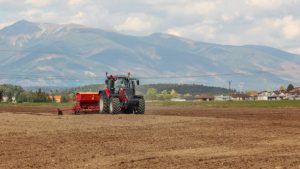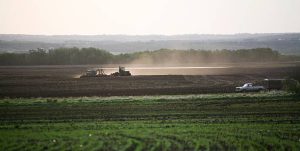An air seed drill is a type of seed drill that uses a pneumatic system to deliver seeds to the ground. It utilizes air pressure to transport the seeds from the seed hopper to the planting mechanism, ensuring precise seed placement and spacing. Air seed drills are commonly used in modern agricultural practices to improve the efficiency and accuracy of seeding operations.
Components of an Air Seed Drill: The Heart of Efficiency
At the core of the air seed drill’s efficiency lie its meticulously crafted components. The seed hopper, akin to the heart of the machine, cradles the seeds awaiting deployment into the soil. The distribution system and seed meters work in harmony to ensure a precise and uniform distribution of seeds. Ground-engaging tools, notably the seed openers, play a pivotal role in creating the perfect furrows for optimal seed placement.
- Seed Hopper: The machine is equipped with a seed hopper, which stores the seeds that will be sown.
- A metering system: controls the flow of seeds from the hopper to ensure a consistent and even distribution.
- Air Distribution: Compressed air is often used to transport the seeds through tubes or hoses from the metering system to the distribution mechanism.
- Distribution Mechanism: The distribution mechanism, often consisting of tubes and nozzles, releases the seeds evenly across the soil as the drill moves forward. This ensures proper spacing between seeds for optimal plant growth.
- Depth Control: Air seed drills may also have features for adjusting the depth at which seeds are planted to accommodate different types of crops and soil conditions.
The use of air seed drills improves efficiency in large-scale farming operations by automating the seeding process, reducing the need for manual labor, and ensuring a more uniform distribution of seeds. This technology contributes to higher crop yields and improved crop management practices in modern agriculture
How Does it Work: Precision in Motion
Picture this: compressed air as the driving force behind a symphony of precise seed placement. The air seed drill’s operation is elegantly simple yet remarkably effective. Compressed air propels seeds from the hopper through the distribution system and into the awaiting soil. The result? Uniform seed distribution and optimal seed depth, translate into improved crop yields.
Soil Conditions: Nurturing the Seed’s Journey
For the air seed drill to perform its magic, the stage must be set just right – enter soil conditions. Loose, well-prepared soil is the canvas upon which this agricultural masterpiece unfolds. Adequate soil moisture becomes the brushstroke that ensures proper seed germination. Farmers, armed with knowledge about their soil, can harness the full potential of the air seed drill.
Difference Between Air Seeder and Air Planter: Decoding Precision
In the realm of farming machinery, terms are often tossed around with abandon. However, understanding the nuances can make all the difference. An air seeder and an air planter, though seemingly synonymous, serve distinct purposes. While an air seeder focuses on even seed distribution, an air planter goes a step further, incorporating features for precise seed spacing and depth control. Knowing these distinctions is akin to choosing the right tool for the job.
Benefits of Air Seed Drill: Beyond the Fields
speedy work:
Time is of the essence in agriculture, and the air seed drill takes this mantra to heart. With the ability to cover vast expanses of land swiftly, farmers can optimize their time and resources, ensuring a more efficient planting process.
Durability:
Farm machinery is no small investment, and durability becomes a key consideration. Enter the air seed drill, constructed with robust materials and cutting-edge technology. Its reputation for durability ensures that farmers make a sound, long-term investment in their agricultural endeavors.
Time-Saving:
Efficiency and time-saving go hand in hand. The precision and speed of the air seed drill drastically reduce the time needed for planting, allowing farmers to reallocate resources effectively. This not only boosts productivity but also opens avenues for diversification and improved crop management.
Tips for Buying a Used Seed Drill: Navigating the Second-Hand Market
Venturing into the realm of used seed drills requires a discerning eye and a checklist of considerations:
Review the Exterior:
Inspect the exterior for signs of wear, rust, or damage. A well-maintained exterior often hints at the overall care the machine has received.
Check the Specs:
Verify that the specifications align with your farming requirements. Ensure all components are in working condition and meet the demands of your agricultural practices.
Inspect the Air Tank:
The air tank is the lifeblood of the air seed drill. Check for any leaks or damage that may compromise its functionality.
Examine the Seed Openers:
Seed openers are crucial for proper seed placement. Ensure they are in good condition, free from excessive wear or damage.
Inspect the Electronics:
Modern seed drills come equipped with electronic components. A thorough check of the control panel and sensors ensures that the technological aspects are in working order.
Check the Undercarriage:
Examine the undercarriage for signs of wear or damage. A well-maintained undercarriage contributes to the overall longevity and performance of the seed drill.
Background Check:
Gather information on the machine’s history. Maintenance records and any past issues can provide valuable insights into the condition of the used seed drill.
Types of Air Seed Drill: Navigating Diversity
The world of air seed drills isn’t a one-size-fits-all affair. Different types cater to varied farming needs:
Box Drills:
Simple yet effective, box drills are a common choice for their versatility and ease of use. They suit a range of crops and are ideal for farmers looking for a straightforward solution.
Hoe Drills:
Perfect for working in heavy residue conditions, hoe drills excel at cutting through debris and creating optimal furrows for seed placement. Their adaptability makes them a valuable asset in diverse farming scenarios.
Disc Drills:
With their ability to handle a variety of soil types, disc drills are a popular choice for farmers dealing with less-than-ideal planting conditions. The discs efficiently cut through residue, preparing the soil for precise seed placement.
Conclusion: The Future of Farming Unfolds
In the grand tapestry of agriculture, the air seed drill stands as a testament to innovation and efficiency. Its components, functionality, and benefits paint a picture of a tool that not only streamlines processes but also enhances the very foundation of farming. As we navigate the distinctions between air seeders and air planters, explore the benefits of speed and durability, and offer insights into purchasing used equipment, it becomes clear that the air seed drill is more than just a machine—it’s a transformative force in modern agriculture. So, as farmers continue to sow the seeds of progress, the air seed drill remains a steadfast companion, ensuring a bountiful harvest for generations to come.





